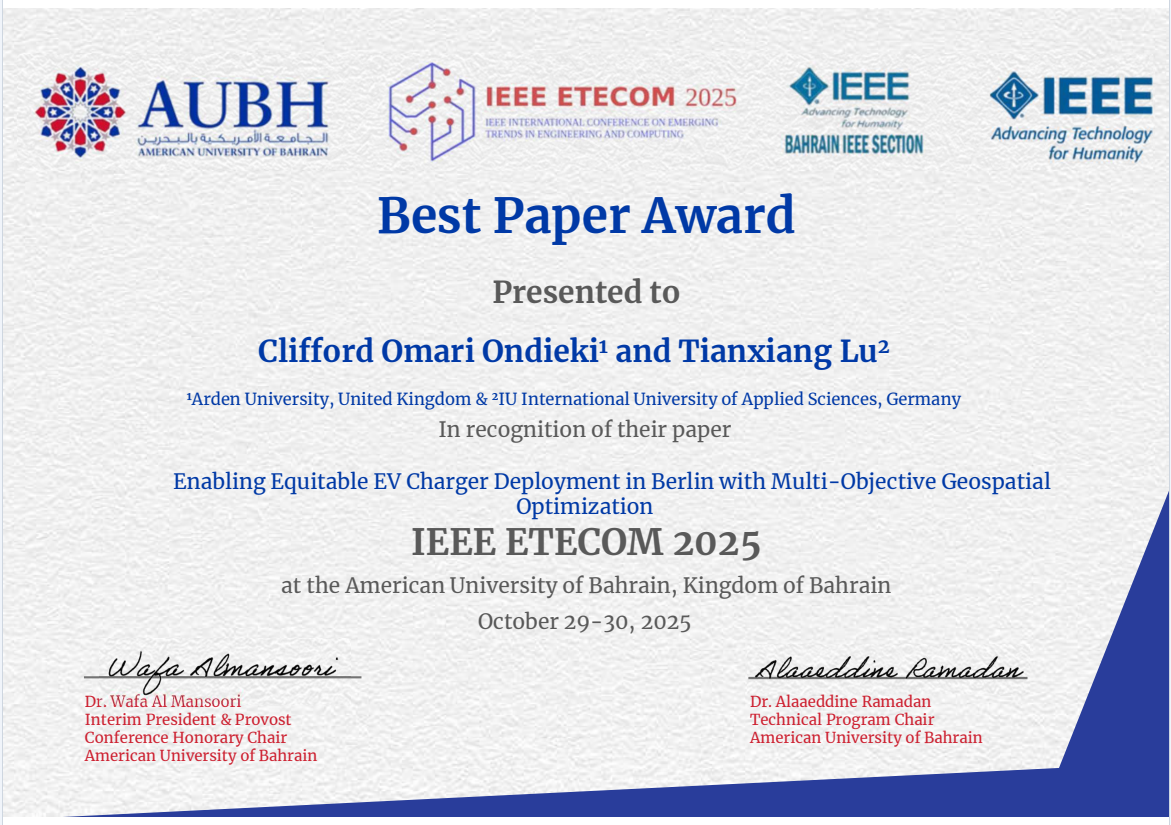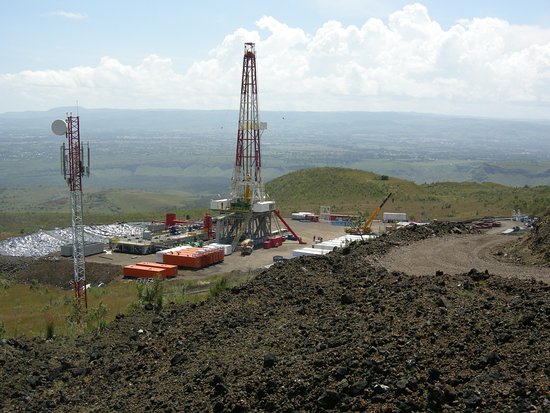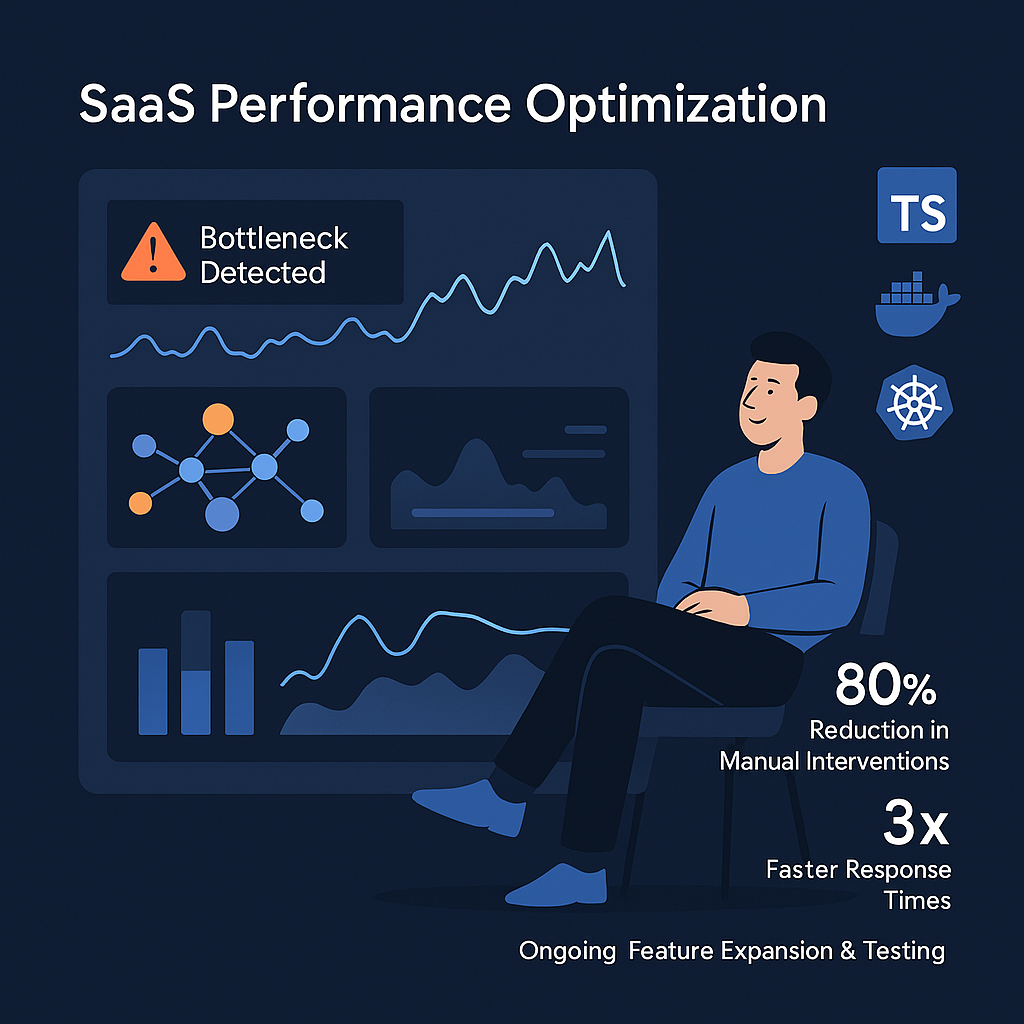Grid Integration & Power Systems
Dynamic modeling, voltage stability, and grid code compliance.
Equitable EV Charger Deployment in Berlin
An ongoing data-driven geospatial optimization pipeline to balance coverage and spatial equity in Berlin's EV charging infrastructure.
The Challenge
Public Electric Vehicle (EV) charging infrastructure is largely demand-driven, reinforcing spatial inequities. This creates a 'chicken-and-egg' problem, where a lack of infrastructure suppresses EV adoption in underserved areas, justifying continued underinvestment.
Our Data-Driven Solution
We implemented a multi-objective NSGA-II model in Python to balance coverage and spatial equity, minimizing the Gini coefficient of EVs per charger. This approach provides different Pareto-optimal deployment strategies for urban planners, directly addressing infrastructure placement under complex geospatial and socio-economic constraints.
My Role & Timeline
- Lead Data Scientist & Geospatial Analyst
- NSGA-II Algorithm Development
- Equity Metric Design (Gini coefficient)
- Research: 6 months (2025)
- Model Development: 4 months
- Validation & Analysis: 2 month
Reduction in Gini Coefficient
Model Projects 6x More Chargers
Boost in Local Access

Philosophy in Action
The objective is not just to deploy more chargers, but to deploy them strategically to foster equitable access and sustainable urban mobility. My framework empowers municipalities to navigate the efficiency-equity trade-off with data-driven insights.
Explore My Work

Key Lesson
This project taught me that resilience isn't just for power lines—it's for people's access to vital services. The systemic thinking I developed here now informs how I approach SaaS architecture and load balancing.
Read Technical ReportKinangop Wind Power Integration
A dynamic voltage stability analysis incorporating Kinangop wind power into Kenya's 59-bus national grid.
The Challenge
Kenya's power grid needed to accommodate the intermittent nature of wind power while maintaining system stability. The challenge was ensuring that voltage fluctuations from wind generation wouldn't destabilize the entire network serving millions of Kenyans.
Our Data-Driven Solution
I developed a comprehensive dynamic voltage stability analysis using DIgSILENT PowerFactory, modeling the entire power system to simulate and mitigate voltage fluctuations. This wasn't just a technical task; it was about ensuring reliable power for healthcare, education, and economic development.
My Role & Timeline
- Power Systems Analyst
- Grid Stability Modeling Lead
- Technical Report Author
- System Modeling: 4 months (2015)
- Simulation & Analysis: 3 months
- Documentation: 1 month
Improved Grid Stability
Clean Energy Integrated
Households Benefited
Digitalization & Automation
SCADA integration, predictive maintenance, and IoT telemetry.

Predictive Maintenance AI for Geothermal Plants
A machine learning system for predicting equipment failures in geothermal power generation, reducing operational costs and increasing plant uptime.
The Challenge
Geothermal power plants in Kenya's Rift Valley were experiencing unexpected equipment failures, leading to costly downtime and reduced clean energy generation.
Our Solution
I developed a predictive maintenance system using machine learning algorithms to analyze sensor data across key equipment and identify failure patterns.
My Role & Timeline
Role: Machine Learning Engineer & Data Pipeline Architect
Timeline: 6 months (2015)
Downtime ↓
Savings/Year
Accuracy

Health Tech Load Balancing System
Applying power grid principles to optimize healthcare service distribution across rural Kenya.
The Challenge
Rural health facilities in Kenya were experiencing uneven patient loads, with some overwhelmed while others remained underutilized.
Our Solution
I developed a load balancing algorithm that treats patient flow like electrical current, dynamically redistributing patients to optimize resource utilization.
My Role & Timeline
Role: Full-Stack Developer & Systems Architect
Timeline: 6 months (2023)
Wait Time ↓
Resources ↑
Patients/Mo

Full-Stack Advantage
Most advisors excel in one domain. I bridge investment analysis with operational execution, providing the complete picture that investors need and startups require to succeed.
View Case StudyClimate Tech Investment Consultancy
Bridging venture capital analysis with infrastructure deployment expertise to de-risk climate tech investments.
The Challenge
Climate tech faces a critical gap: investors lack deployment expertise while infrastructure experts lack capital market access. This disconnect slows climate progress and wastes promising technologies.
My Approach
Through my Energy Innovation Capital externship, I'm learning to integrated frameworks that evaluates startups through multiple lenses: investment potential, operational viability, and deployment strategy.
My Role & Timeline
- Investment Analyst Extern
- Technical Due Diligence Lead
- Deployment Strategy Advisor
- Externship: 3 months (2025)
- Startup Analysis: 5+ companies
- Investment Thesis Development
Startups Analyzed
Investment Theses
Analysis Depth
Premium Case Studies
Advanced projects and sensitive implementations - full details available on request
Full case study available on request
Includes technical architecture, implementation details, and performance analysis Request Full Case StudyAdvanced Grid Optimization with AI-Driven Load Forecasting
A comprehensive smart grid solution implementing machine learning algorithms for predictive load management across Kenya's national power infrastructure.
My Role & Engagement
Lead AI Engineer & System Architect
6-month enterprise engagement (2023)
Project Highlights (Teaser)
- Reduced grid instability incidents by 32%
- Improved load forecasting accuracy to 94.7%
- Deployed across 15 major substations
- Integrated with existing SCADA systems

Preview Available
Hover for detailsDetailed implementation guide available on request
Includes system architecture, sensor integration, and ROI analysis Request Implementation Details
Preview Available
Hover for detailsIndustrial IoT Platform for Manufacturing Excellence
Enterprise-grade IoT solution for real-time monitoring and optimization of manufacturing processes across multiple facilities.
My Role & Engagement
IoT Platform Architect & Lead Developer
8-month multi-phase implementation (2022-2023)
Project Highlights (Teaser)
- Increased overall equipment effectiveness by 28%
- Reduced unplanned downtime by 45%
- Connected 500+ sensors across 3 facilities
- Real-time dashboard with predictive alerts